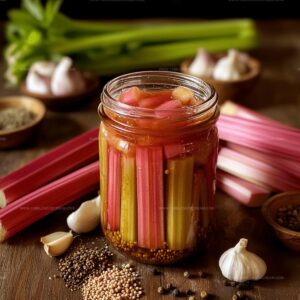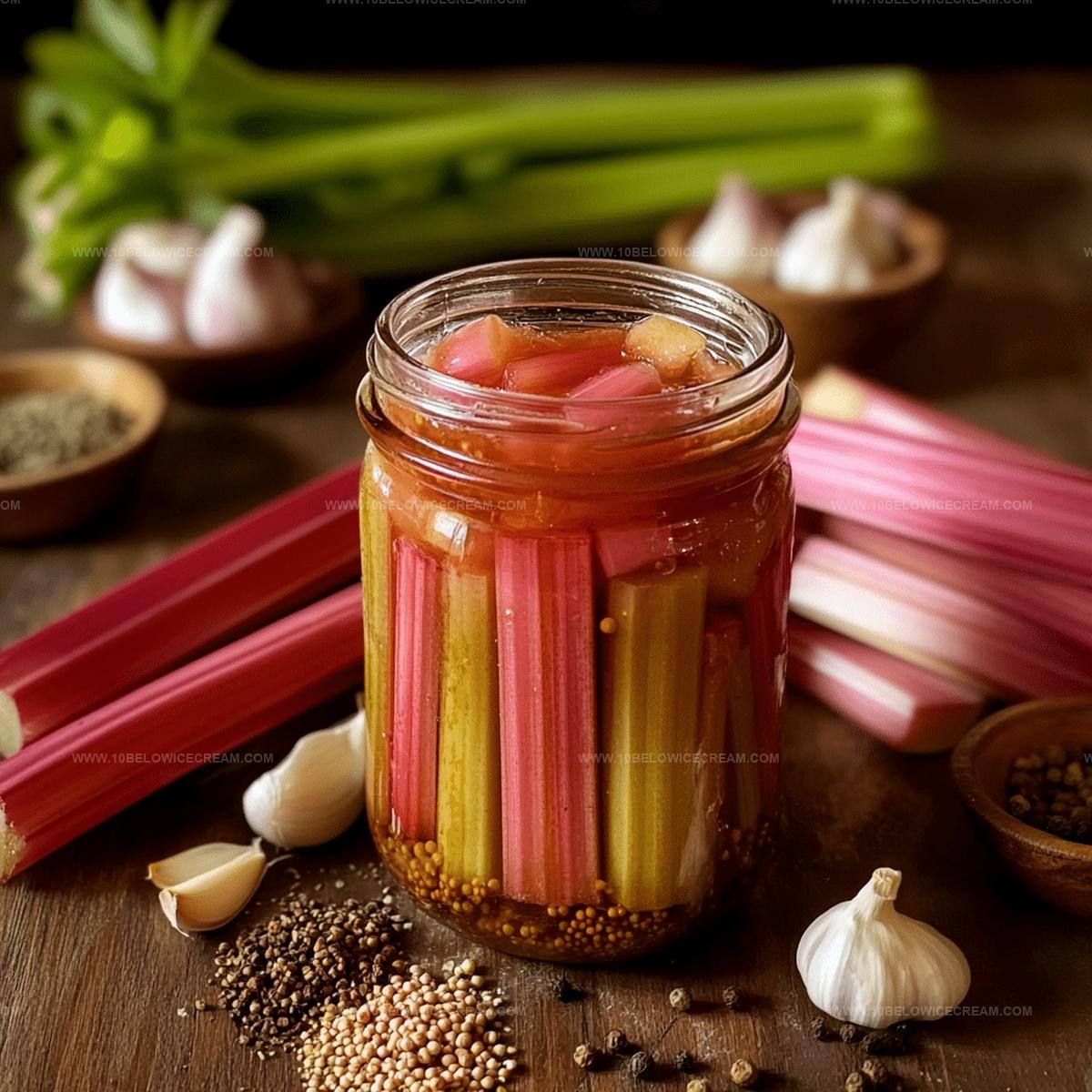Quick Homemade Rhubarb Pickles Recipe: Sweet-Tangy Bliss
Crisp summer gardens often yield a surprising rhubarb pickle that transforms ordinary condiments into something extraordinary.
Stalks of ruby-red tartness create magical culinary moments in kitchens everywhere.
Tangy and bright, these pickles surprise palates with unexpected zings of flavor.
Pickling brings out incredible depths in rhubarb’s natural sharpness, making each bite a revelation.
Simple ingredients and straightforward techniques make this recipe accessible to novice and experienced cooks alike.
Salt, vinegar, and fresh rhubarb combine in ways that challenge traditional preservation methods.
You’ll want to slice these pickles thin and experiment with their bold, complex profile.
Prepare to shock your taste buds with a condiment that defies expectations.
Rhubarb Pickle Confusion? Let’s Sort It Out
Yes, apple cider vinegar works perfectly and adds a slightly sweeter, fruitier flavor profile to the pickled rhubarb.
Select rhubarb stalks that are firm, bright colored, and free from blemishes or soft spots, indicating peak freshness and quality.
Fresh dill provides the best flavor and aroma, but dried dill can be used if fresh is unavailable, though the taste will be slightly less vibrant.
Absolutely! Increase or decrease red pepper flakes to customize the heat intensity according to your personal spice preference.
Rhubarb… Pickled?! Here’s Why It Totally Works
What You’ll Need for That Tangy Rhubarb Crunch
For the Vegetables:For the Spices and Seasonings:For the Pickling Liquid:How to Make Rhubarb the Unexpected Star
Step 1: Prepare Rhubarb
Wash rhubarb stalks under cool running water, removing any dirt or debris. Trim off tough woody ends and slice stalks into uniform 2-inch batons, ensuring consistent size for even pickling.
Step 2: Set Up Pickling Jar
Select a clean, sterilized glass jar large enough to hold all rhubarb pieces. Wipe the interior with white vinegar to eliminate potential bacteria and create a sterile environment.
Step 3: Create Pickling Brine
In a non-reactive saucepan, combine:Heat the mixture, stirring until salt and sugar completely dissolve, creating a flavorful pickling liquid.
Step 4: Add Aromatic Ingredients
Prepare and add to the jar:Step 5: Arrange Rhubarb
Carefully position rhubarb batons vertically inside the jar. Pack them tightly but gently, minimizing air pockets while preventing crushing.
Step 6: Enhance Flavor and Color
Sprinkle turmeric powder over the rhubarb to add vibrant color and subtle earthy notes. Pour the hot pickling brine over the vegetables, ensuring complete submersion.
Step 7: Add Fresh Herbs
Tuck fresh dill sprigs between rhubarb pieces to introduce aromatic complexity and traditional pickling appearance.
Step 8: Cool and Seal
Seal the jar tightly and allow it to cool at room temperature for approximately 1 hour before transferring to the refrigerator.
Step 9: Allow Flavor Development
Let pickles mature in the refrigerator for a minimum of 48 hours, allowing flavors to meld and intensify before enjoying.
Step 10: Store and Enjoy
When stored properly in the refrigerator, these rhubarb pickles will maintain optimal flavor and texture for up to 3 weeks.
Tips to Keep Those Pickles Crisp and Lively
Think Beyond the Jar – Rhubarb Pickle Twists
What Rhubarb Pickles Love to Be Served With
Chill or Seal? Rhubarb Pickle Storage Made Easy
Print
Homemade Rhubarb Pickles Recipe
- Total Time: 1 hour 30 minutes (including cooling and minimum maturing time)
- Yield: 6 1x
Description
Zesty “homemade rhubarb pickles” bring tangy Mediterranean charm to crisp summer tables. Sweet-sour pickles offer garden-fresh excitement that elevates sandwiches, salads, and charcuterie boards with bold, unexpected flavor.
Ingredients
Rhubarb Pickles:
Main Ingredients:
- 2 pounds fresh rhubarb stalks
- 2 cups white vinegar
- 1 cup water
Seasoning and Spices:
- 3 tablespoons kosher salt
- 2 tablespoons sugar
- 2 cloves garlic
- 1 tablespoon mustard seeds
- 1 tablespoon black peppercorns
- 2 bay leaves
Aromatics and Herbs:
- 1 small red onion
- 2 sprigs fresh dill
- 1 teaspoon red pepper flakes
- 1/2 teaspoon turmeric powder
Instructions
- Thoroughly wash rhubarb stalks and trim off any woody ends, then slice into uniform 2-inch batons ensuring consistent pickling.
- Prepare a clean, sterilized glass jar large enough to accommodate all rhubarb pieces, wiping interior with white vinegar to eliminate potential bacteria.
- Combine white vinegar, water, kosher salt, and sugar in a non-reactive saucepan, heating mixture until salt and sugar completely dissolve, creating a precise pickling brine.
- Peel and thinly slice garlic cloves and red onion, adding them directly into the prepared jar along with mustard seeds, black peppercorns, bay leaves, and red pepper flakes.
- Carefully arrange rhubarb batons vertically inside the jar, ensuring they are tightly packed but not crushed, leaving minimal air pockets.
- Sprinkle turmeric powder over rhubarb for additional color and subtle earthy flavor, then gently pour hot pickling brine over the vegetables, completely submerging them.
- Tuck fresh dill sprigs between rhubarb pieces for aromatic complexity and traditional pickling appearance.
- Seal jar tightly and allow to cool at room temperature for approximately 1 hour before refrigerating.
- Let pickles mature in refrigerator for minimum 48 hours, allowing flavors to develop and intensify before consuming.
- Stored properly, these rhubarb pickles will maintain optimal flavor and texture for up to 3 weeks in refrigerated conditions.
Notes
- Slice rhubarb uniformly to ensure even pickling and consistent texture throughout the jar.
- Sterilize glass containers thoroughly with white vinegar to prevent bacterial growth and maintain pickle safety.
- Choose fresh, firm rhubarb stalks without blemishes to guarantee crisp, vibrant pickles with maximum flavor retention.
- Experiment with spice variations like adding coriander seeds or replacing red pepper flakes with fresh chili for personalized heat levels.
- Prep Time: 20 minutes
- Cook Time: 10 minutes
- Category: Snacks, Appetizer
- Method: Pickling
- Cuisine: American
Nutrition
- Serving Size: 6
- Calories: 20
- Sugar: 1 g
- Sodium: 600 mg
- Fat: 0 g
- Saturated Fat: 0 g
- Unsaturated Fat: 0 g
- Trans Fat: 0 g
- Carbohydrates: 4 g
- Fiber: 1 g
- Protein: 1 g
- Cholesterol: 0 mg


Jackson Reid
Founder & Recipe Developer
Expertise
Education
Holyoke Community College – HCC-MGM Culinary Arts Institute
Certificate in Culinary Arts
Focus: Farm-to-table cuisine, sustainable cooking practices, and hands-on kitchen training
Jackson’s love for cooking began one dish at a time. After earning his Culinary Arts Certificate from Holyoke Community College’s HCC-MGM Culinary Arts Institute, he focused on what mattered most: creating recipes that are simple to follow and full of flavor.
At 10 Below Ice Cream, Jackson brings together global influences and a less-is-more approach. His recipes reflect his belief that good food doesn’t need to be complicated; it just needs to make sense, taste great, and feel right.
When he’s not testing ingredients or adjusting seasonings, you’ll find him hiking near Asheville, exploring local markets, or chasing the best light for food photos.